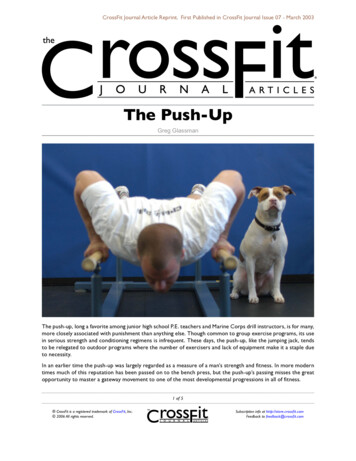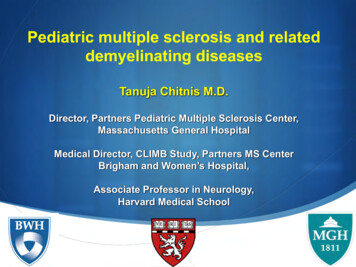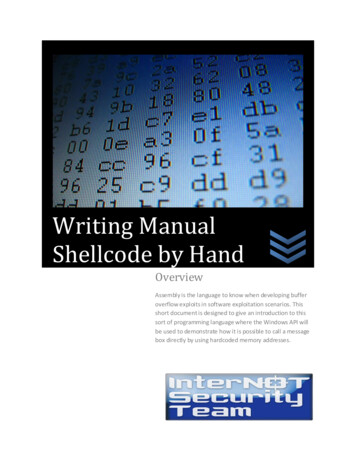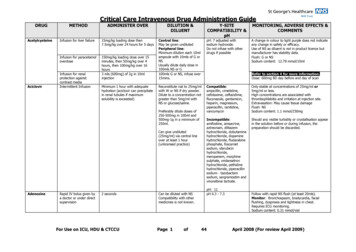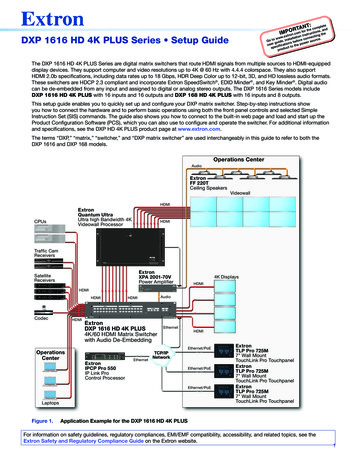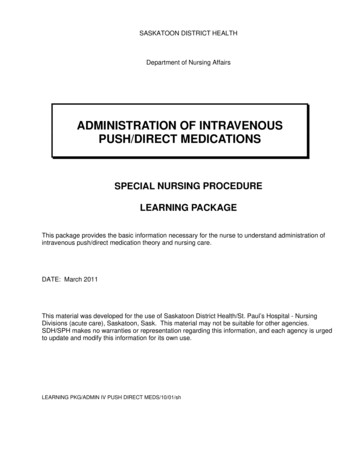
Transcription
SASKATOON DISTRICT HEALTHDepartment of Nursing AffairsADMINISTRATION OF INTRAVENOUSPUSH/DIRECT MEDICATIONSSPECIAL NURSING PROCEDURELEARNING PACKAGEThis package provides the basic information necessary for the nurse to understand administration ofintravenous push/direct medication theory and nursing care.DATE: March 2011This material was developed for the use of Saskatoon District Health/St. Paul’s Hospital - NursingDivisions (acute care), Saskatoon, Sask. This material may not be suitable for other agencies.SDH/SPH makes no warranties or representation regarding this information, and each agency is urgedto update and modify this information for its own use.LEARNING PKG/ADMIN IV PUSH DIRECT MEDS/10/01/sh
Administration of Intravenous Push/Direct Medications Learning PackagePage: iPermission for extensive copying of this Learning Package for scholarly purposes may be granted bythe Department of Nursing Affairs. It is understood that due recognition will be given to theCoordinator(s) of this Learning Package and to the Department of Nursing Affairs in any use of thismaterial. Copying, publication or any other use of this Learning Package for financial gain withoutapproval is prohibited.Requests for permission to copy or to make other use of the material in this Learning Package, inwhole or in part, should be addressed to:Department of Nursing Affairsc/o Nursing OfficeRoyal University HospitalSaskatoon, Sask.S7N 0W8c/o Nursing OfficeSaskatoon City HospitalSaskatoon, Sask.S7K 0M7c/o Nursing OfficeSt. Paul’s HospitalSaskatoon, Sask.S7M 0Z9ACKNOWLEDGMENTS:Coordinated by:Helen SabadashClinical Nurse Educator, Royal University HospitalSpecial thanks to:Teresa PidduckClinical Nurse Educator, Royal University HospitalCarey Redekopp-KroegerClinical Nurse Educator, Royal University HospitalNote On-line version available to Saskatoon Health Region employees athttp://learning.saskatoonhealthregion.ca
Administration of Intravenous Push/Direct Medications Learning PackagePage: iiTABLE OF CONTENTS:Page No.1.0Introduction.11.1Certification in Administration of IV Push/Direct medication .11.2Criteria for Certification .11.3Objectives .1Theory .22.1Definition .22.2Checking .22.3Administration of IV Push Decision Tree .32.4IV Medication Reference Manual Monographs .42.5Potential Complications .52.6Administering the Medication .62.7Documentation and Reporting.72.8Summary.72.9Answers for Study Questions.83.0Policy and Procedure: Administration of Intravenous Push/Direct Medication .94.0Appendix - A. IV Reference Manual Monograph Sample . 13B. IV Reference Manual Monograph-Answer Sheet. 15C. Sample MAR . 175.0Review Quiz . 182.0
Administration of Intravenous Push/Direct Medications Learning Package1.0INTRODUCTION1.1Certification in Administration of IV Push/Direct MedicationsPage: 1Registered Nurses, Graduate Nurses and Registered Psychiatric Nurses (RN, GN,RPN)identified by the managers in designated practice settings will be certified inAdministration of IV Push/Direct Medication. Successful completion of this module willcomplete the theory portion of the IV push/direct medication certification. Followingcompletion of this module you will be required to demonstrate the skill to a ClinicalNurse Educator or certified RN/GN/RPN to complete the skill certification.1.2Criteria for Certification1.2.1 Review of the learning package.1.2.2 Completion of the Review Quiz (Section 5)1.2.3 Demonstration of the skill.1.3ObjectivesUpon completion of this learning package you should be able to: Define IV push/direct administration of medications Identify the steps in safely administering medication by the IV push/direct route Identify medication information resources Calculate the dosage of medications Identify complications of IV push/direct routeMedication given IV Push/Direct
Administration of Intravenous Push/Direct Medications Learning Package2.0THEORY2.1DefinitionPage: 2What is an IV push/direct medication? IV push/direct means the manual administration of a small volume of medicationor concentrated solution directly into the venous system. It does not refer to a medication placed on a pump or is added to an IV bag.Why give a medication by the IV push/direct route? Giving a medication IV push/direct means more immediate and predictabletherapeutic effects. The health care team is able to quickly respond to a patient’s needs. Some medications can only be absorbed intravenously. The IV route is often required if the patient is unable to take oral medications. Administration can be discontinued immediately if an adverse reaction occurs.Please review SHR policy: Administration of IV Push/Direct medications (Page 9)2.2CheckingPrior to giving an IV Push Medication various safety checks are performed: Check physician's order to determine medication, dose, route and frequency ofadministration. Using available resources (IV Medication Reference Manual, CPS, Pharmacy):1. Check if medication can be given IV push/direct2. Check if the monitoring requirements can be met on your unit (see Decision Tree 2.3)3. Review information about the medication, including action, purpose, peakonset, normal dose, side effects, and dilution Check that it is the right patient, right drug, right dosage, right time, rightdilution/compatibility, right flow rate and right route. For High alert medications, an independent double check and documentation isrequired. Check for any incompatibilities of IV medications. Check for any known allergies and monitor for any reactions during administration. Watch for IV related complications; ensure venous access is patent prior toadministering the medication. Some medications can cause severe tissue damageif injected into the tissue (extravasation).
Administration of Intravenous Push/Direct Medications Learning Package2.3Page: 3Administering a Medication IV Push/Direct Decision TreeShould medication be given IV Push/Direct?Can the patient be monitored safely?Check the IV Medication Reference Manual monograph forAdministration: Can the medication be given direct into IV tubing?Check the Requirements and Required Monitoring: Can therequirements and required monitoring be done in your unit?YesNoNo - IV Medication ReferenceManual monograph does notrecommend giving by IVPush/Direct route or requirements&/or monitoring cannot be doneon unitYes - IV Medication Reference Manual monograph confirms route; requirementsand monitoring parameters can be met.Do not give medication IV Push.Choose different route. If anotherroute is not possible, discuss otheroptions with physician.Peripheral Saline Lock- vigorously scrub needlelessadapter with alcohol, allowto dry- flush with 0.9% SodiumChloride, ensure IVpatency- attach medication syringeand inject at correct rate- flush with 0.9% SodiumChloride at same rate until0.5 mls remains in thesyringe, while maintainingpositive pressure, clampthe extension tubing. (Flushwith Heparin flush solutiononly if ordered or if unitpolicy)Central Venous Catheter- vigorously scrubneedleless adapter endwith alcohol, allow todry- flush with 0.9% SodiumChloride- attach medicationsyringe-administer medicationat correct rate-flush with 0.9% SodiumChloride at same ratethen with Heparin flush(if indicated in CVCguidelines)Check IV Medication ReferenceManual -monograph for otherinformation e.g. reconstitution,dosage, precautions. Check forpatient allergies.Choose method of delivery:Peripheral Saline Lock, CentralVenous Catheter, IV Tubing.Prepare medication with correctdilution.IV Tubing-vigorously scrub y-site port(closest to insertion site) withalcohol, allow to dry- If medication is compatible withthe IV solution: attachmedication syringe to connector,administer medication at correctrate- flush with 0.9% Sodium Chlorideat same rate-if medication is incompatiblewith the IV solution: stop the IV,scrub Y-site with alcohol, allow todry, flush with 0.9% SodiumChloride before and afteradministering medicationMonitor patient following administration of medication as indicated on the IV Medication ReferenceManual-monograph.
Administration of Intravenous Push/Direct Medications Learning Package2.4Page: 4IV Medication Reference Manual MonographsPractice using the IV Medication Reference Manualmonograph with this patient scenario:Maureen McFee is a 70 year old woman who is a patient on asurgical unit. She is a post-op patient recovering fromabdominal surgery. The physician has an order on the chart for2- 5 mg Morphine IV push q 4 hrs.Using the IV Medication Reference Manual Monograph Sample- AppendixA answer the following questions: Is this medication drug appropriate for IV push?Is this the correct dose?What monitoring is required?What are the desired effects?What are the possible adverse effects?Check your answers:See Appendix B - IV Medication Reference Manual Monograph Sample-AnswerpageThis is a High Alert medication –Saskatoon Health Region requires anindependent double check and documentation for these medications atcertain concentrations.(For complete policy see: Regional Policy 7311-60-020 High AlertMedications-Identification, Double Check and Labelling)High-Alert Medications are medications that bear a heightened risk of causingsignificant patient harm when used in error (as defined by the Institute for SafeMedication Practices).Independent Double-Check means a second independent check by a secondhealthcare professional confirming the medication correctly reflects the originalprescribed medication order, and the medication administration is in accordance withthe drug monograph and / or respective policy.An independent double-check is required prior to the administration of anydose which requires use of the following high-alert medications: insulin (excluding subcutaneous insulin administered through Home Care), intravenous anticoagulants concentrated electrolytes, chemotherapeutic agents, high potency narcotics, intravenous vasoactive agents and neuromuscular blocking agents.
Administration of Intravenous Push/Direct Medications Learning PackagePage: 5High Potency NarcoticsHigh-potency narcotics include dosage forms of: Hydromorphone injection greater than 2mg/mL, Morphine injection greater than 10mg/mL (adults), Morphine injection greater than 2mg/mL (pediatrics), Fentanyl injection greater than 250mcg/5mL.2.5Potential ComplicationsComplications to watch for in a patient receiving IV Push medications includecomplications associated with venous access: thrombophlebitis, infection, infiltrationand complications associated with medications: extravasation, allergic reactions andspeed shock. Review the complications with these problem solving questions:1.Prior to administering an IV push medication, you assess the patient’s IV. The IVcannot be flushed and the patient tells you his IV “hurts.”i)What are the causes of thrombophlebitis in an IV?ii) What is one symptom of thrombophlebitis?iii) You cannot flush the IV. Can you still give the IV push medication through thisIV?2.Your patient has an order for Ancef (Cefazolin). You check the patient’s chartand ask the patient if he has any allergies. After finding no evidence that thisperson would be allergic to the medication, you begin to administer themedication IV Push. After about 1/3 of the medication has been administered,you notice that the patient’s face is suddenly flushed.i) What could be the cause?ii) What is a sign or symptom of an allergic reaction?iii) What is the appropriate intervention when an allergic reaction is suspected3.You are receiving an admission from ER. They report on the care the patientreceived. The patient experienced Speed Shock after receiving a medication IVpush.i) What is Speed shock?ii) What are the signs and symptoms?iii) How can you prevent this from happening?
Administration of Intravenous Push/Direct Medications Learning Package4.Page: 6Prior to administering medications you check the IV for any signs of Infection.i) Signs of infection in an IV include.ii) IV infections can be prevented by:5.An interstitral IV allows the IV fluid or medication to infiltrate into the tissuesinstead of into the vein. Extravasation is when this medication causes damageto the tissues.i) What are signs/symptoms of infiltration?ii) How can you decrease the risk of infiltration and extravasation?(check your answers Section 2.9)2.6Administering the MedicationAfter you have done the appropriate checking, you can gather your supplies,calculate the correct dosage and administer the drug.Supplies required: Medication Administration Record (MAR)(take it into the room) IV medication Alcohol swabs Syringe with needle or blunt needle Medication Medication label Diluents (sterile saline/water) 0.99% Sodium Chloride flush syringes Heparin flush (if using a central venous catheter that requires it)Calculate the dosageNote: In some circumstances the medication dose will need to be calculated by age,height, and weight or body surface area.Calculate the dosage for these examples:Example 1: A physician writes an order for administration of an IV push medication for apatient with pulmonary edema. The order is for Furosemide (Lasix) 35mg IV push stat.The vial of Furosemide contains 4mls – each ml contains 10 mg of Furosemide. Howmuch would you draw up?Example 2: Diphenhydramine (Benadryl) 12.5 mg IV is ordered for a patient having anallergic reaction. The ampule of Diphenhydramine contains 1 ml – each ml contains50mg of Diphenhydramine. How many mls do you draw up?(check your answers –Section 2.9)
Administration of Intravenous Push/Direct Medications Learning PackagePage: 7Administer the MedicationIV push medication can be given through a Peripheral Saline Lock, IV tubing or through a Central VenousCatheter. (For procedures see SHR policy: Administration of IV Push/Direct medications ‐Page 9)2.7Documentation and ReportingThis final step in the IV push process is documentation and reporting.2.8 Chart on the Medication Administration Record (MAR). IV medications should bedocumented immediately after administration. Include the time, dosage, route, initials and co-signer if dose needs to bedouble-checked. (see Appendix C - for Sample MAR) Chart patient response to medication. For pediatric patients: record flush solution on MAR and volume if fluid restrictedon daily flow sheet/fluid balance record. NICU/PICU record medication and flush volume on IV intake record. Report to physician if medication is not effective or if the medication causes anyadverse effects.SummaryNow that you’ve reviewed the steps of IV push medication administration, it’s time totest your knowledge. To complete this module, you must take the final Review Quiz.
Administration of Intravenous Push/Direct Medications Learning Package2.9Page: 8Answers for Study QuestionsPotential Complications - Problem Solving (Section 2.5)Answers:1. i) clot formation due to irritation ii) pain along the vein iii) no2. i) possible allergic reaction to the medication ii) Rash, facial swellingiii)discontinue administering the medication & notify the physician3. i) medication given too fast ii) hypotension, headache flushed face iii) infusemedication and flush at prescribed rate and dilution4. i) pain, edema, purulent discharge, fever ii) good hand washing prior to care,aseptic technique during insertion, catheter care and removal, changing IVevery 96 hours unless contraindicated5. i) pain, burning and swelling around the insertion site; IV infusing poorlyii) check patency of IV prior to administering medications, observe site whileadministering medications and ask patient to alert you regarding anydiscomfort.Administering the Medication - Calculate the dosage (2.6)Answers:Example #1 - 3.5 mls should be drawn upExample #2 - 0.25 mls should be drawn up
Administration of Intravenous Push/Direct Medications Learning Package3.0Page: 9POLICY AND PROCEDURE: Administration of IV Push MedicationTitle:INTRAVENOUS – PUSHMEDICATION ADMINISTRATIONI.D. Number: 1089Authorization:[ ] Board of Directors[ ] MAC Motion #:[x] Tri-Hospital Nursing PracticeCommitteeSource: NursingDate Reaffirmed: November 2010Date Revised: November 2010Date Effective: February 2001Scope: SASKATOON CITY HOSPITALROYAL UNIVERSITY HOSPITALST. PAUL’S HOSPITALAny PRINTED version of this document is only accurate up to the date of printing 26-Apr-11. SaskatoonHealth Region (SHR) cannot guarantee the currency or accuracy of any printed policy. Always refer to thePolicies and Procedures site for the most current versions of documents in effect. SHR accepts noresponsibility for use of this material by any person or organization not associated with SHR. No part of thisdocument may be reproduced in any form for publication without permission of SHR.1.0POLICY:All Nursing Units are targeted for this Special Nursing Procedure:1.1Registered Nurses/Registered Psychiatric Nurses/Grad Nurses identified bytheir manager will be certified to administer IV push medications inaccordance with the guidelines of the institutions, the nursing units andwith the IV Medication Reference Manual.NOTE: RN 4th year nursing students may give IV push/direct medications underthe direct supervision of a certified RN/RPN/GN.1.2IV push/direct medication administration refers to the manualadministration of a relatively small volume of a concentrated solution ormedication directly into the venous system via a peripheral or centralvenous access device. The IV push route should be chosen inemergencies or whenever an immediate drug effect is needed.1.3The nurse must be knowledgeable regarding: compatibility of medication and IV solution maximum dosage and rate of administration desired therapeutic effects possible adverse effects appropriate preparation and dilution required monitoring parameters
Administration of Intravenous Push/Direct Medications Learning Package2.01.4The nurse must check the medication monograph in the IV ReferenceManual to determine if the required monitoring can be met on the unit.NICU: see appropriate IV medication resource. If the monitoringrequirements cannot be met, do not give medication IV Push. If anotherroute is not possible, discuss other options with physician.1.5The nurse must ensure the following: Right patient Right drug Right dosage Right route Right time Right dilution/fluid compatibility Right flow rate Right monitoring Right documentation1.6If the patient has a central venous catheter, administer IV push/directmedication as per this policy and refer to the related policies for CentralVenous Catheter flushing and locking in the Tri-Hospital Policy &Procedure Manual.PURPOSE:2.13.0Page: 10To safely administer approved medications intravenously by push/directroute.PROCEDURE:3.1Supplies: alcohol swabssyringemedicationmedication labelsdiluent, if applicable0.9% Sodium Chloride flushNOTE: NICU – use D5W as per protocolPICU – as per unit protocol3.2Check for patient allergies.3.3Prepare medication as necessary ensuring compatible diluent andcorrect dilution. Attach a completed medication label. Refer to Policy:Medication Administration #1170.NOTE: If more than one medication is to be administered and incompatibilitiesexist, flush with 0.9% Sodium Chloride (NICU – D5W as per protocol)between each medication.
Administration of Intravenous Push/Direct Medications Learning Package3.4Examine insertion site and ensure patency.3.4.13.4.23.5Page: 11If using a running intravenous, observe for free flow of IV solution.If using a saline/heparin lock, assess ease of flush.Using Peripheral Intravenous Tubing Port (Y-Site):3.5.13.5.23.5.33.5.4Vigorously scrub y-site port closest to insertion site with alcohol.Allow to dry.If medication is compatible with the IV solution, attach medicationsyringe to y-site port by pushing and twisting until tight. Inject at thecorrect rate, and then flush y-site port with 0.9% Sodium Chloride.If medication is incompatible with the IV solution, stop the IVinfusion, scrub y-site port with alcohol, flush with 0.9% SodiumChloride and inject medication at the correct rate. Scrub y-siteport with alcohol and flush again with 0.9% Sodium Chloride.Re-establish infusion.NOTE: The flush following medication administration must be delivered at thesame rate as the medication injection.3.6Using a Peripheral Saline Lock3.6.13.6.23.6.33.6.43.7Vigorously scrub needleless adapter with alcohol. Allow to dry.Attach syringe with 0.9% Sodium Chloride to needleless adapter bypushing and twisting until tight and flush.Repeat 3.6.1 and attach medication syringe. Inject at correct rate.Repeat 3.6.1 and flush with 0.9% Sodium Chloride until 0.5 mlremains in the syringe. Maintaining positive pressure with thesyringe plunger, clamp the extension tubing. A small amount offluid may remain in the syringe.(NICU – lock with a minimum of double the lumen volume with 0.9%Sodium Chloride after use and q6h) (PICU – heparin flush as per unitprotocol).Documentation and Reporting3.7.13.7.23.7.33.7.43.7.5On the Medication Administration Record (or appropriate record)include date, time, name of drug, dosage, route, initials and cosigner initials if dose is double checked. Refer to Policy:Medication Administration Record (MAR) #1091.On flow sheet/progress note include rationale for administrationand patient response.Pediatric Units: record flush solution on the MAR and volume if fluidrestricted on daily flow sheet/fluid balance record.NICU/PICU: record medication and flush volume on IV intakerecord.Report adverse effects immediately to the physician.
Administration of Intravenous Push/Direct Medications Learning Package4.0Page: 12REFERENCES:1.Crimlisk, J., et al, 2009. Evidence – Based Practice Clinical SimulationsWorkshop and IV Medications Medsurg Nursing, May 1 June. Pg 153 – 160.2.Elkin, M., Perry, A.G., & Potter, P.A. Nursing Interventions Clinical Skills. 3rded. Mosby – an affiliate of Elsevier, St. Louis, MO. Pg 709 – 717.3.Ingram, L., 2008. Safe Practice in Intravenous Medicines Administration.Nursing Standard, Vol. 22 No. 46. Pg 44 – 47.4.Jones, S.W., 2009. Reducing Medication Administration, Errors in NursingPractice. Nursing Standard Vo.l 23 No. 50. Pg 40 – 46.5.Weinstein, S.M., 2007. Plumer’s Principles and Practice of IntravenousTherapy. 8th ed. Lippincott – Williams & Wilkins, Philadelphia, PA., Chapter9.
Administration of Intravenous Push/Direct Medications Learning Package4.0Page: 13APPENDIX A – IV Medication Reference Manual - Monograph Sample
Administration of Intravenous Push/Direct Medications Learning PackagePage: 14
Administration of Intravenous Push/Direct Medications Learning PackagePage: 154.0 Appendix B- IV Medication Reference Manual- Monograph Sample-Answer pageQ. What are thedesired effects?A. AnalgesicQ. Is this drugappropriate for IVuse?A. Yes, this drug canbe given by IVpushQ. What monitoring isrequired?A. Baseline RR, HR,BP sedation andanalgesic scalebefore dose.
Administration of Intravenous Push/Direct Medications Learning PackageQ. What are thepossible adverseeffects?A. Respiratorydepression,hypotension,pruritis, sedation,confusion, nausea,vomiting, urinaryretention.Q. Is this the correctdose?A. Yes, it is within therecommendedrange.Note: Elder AlertPage: 16
Administration of Intravenous Push/Direct Medications Learning Package4.0 Appendix C- Sample MARPage: 17
Administration of Intravenous Push/Direct Medications Learning Package4.0Page: 18REVIEW QUIZAdministering IV Push/Direct Medications Quiz1. Which method of administering a medication is not considered to be IVPush/Direct?a) medication is given into a Central Venous Catheter over 3 minutesb) medication is given into a peripheral saline lockc) medication is given through the secondary port of the IV pumpd) medication is given through the y-site of the IV tubing2. The IV Medication Reference Manual is a resource used to: (circle all that apply):a) check for therapeutic dose ranges for different ages of the populationb) check if the drug needs to be diluted before givingc) find out information on the recommended monitoring for the drugd) find out if the medication is on the Saskatchewan Formulary3. Your patient is exhibiting respiratory depression. Naloxone (Narcan) is ordered 0.1mg IV Push (supplied 0.4mg/ml ampule). How many mls will you draw up?a) 2.5 mlsb) 0.025 mlsc) 0.25 mlsd) 4 mls4. True or False (circle the correct answer):TFFlush IV line before and after medication administration with 0.9% SodiumChloride or D5W (NICU) if incompatibilities exist.TFWhen using a Y-site, the flush following medication administration must bedelivered at the same rate as the medication injection.TF Signs of infection in an IV can include: pain, edema, purulent discharge,fever.5. What is Speed shock?a) medication is given without enough dilutentb) medication is given too fastc) medication is given too slowd) medication is given with too small a syringe causing pressure or “shock”6. How can you prevent speed shock?a) Good hand washing prior to accessing IVb) Use appropriate size syringe for medicationc) Infuse medication and flush at prescribed rate and dilutiond) Assess IV site for infiltration
Administration of Intravenous Push/Direct Medications Learning PackagePage: 197. What is extravasation?a) patient has pain in his IV siteb) patient experiences some pain when medication is infusedc) vesicant or irritant medication was givend) damage to subcutaneous tissue from an interstitial medication8. What is one way nurses can help decrease the chances of extravasation?a) Use aseptic technique during administrationb) ensure patency and position of IV prior to infusionc) Change IV site before administering any IV push drugd) Ensure medication and IV solution are compatible9. Your patient requires Digoxin by IV push. The order is for 0.0625 mg. Digoxin issupplied in a 0.25mg/ml ampule. How many mls will you draw up?a) 4mlsb) 0.4 mlsc) 2.5 mlsd) 0.25 mls10. It is 0530; you have just received an admission from ER. Your patient has an orderfor IV antibiotics for an infected wound. His IV won’t flush. What is theappropriate next step?a)b)c)d)Call Pharmacy and see if they can send the oral form of the antibioticLeave it for the next shift to deal withDiscontinue the IV , insert a new one, so the antibiotic can be given IVTry giving the antibiotic through the IV anyway
onset, normal dose, side effects, and dilution Check that it is the . right patient, right drug, right dosage, right time, right dilution/compatibility, right flow rate and right route. For . High alert medications, an independent double check and documentation is required. Check for any . incompatibilities . of IV medications.
